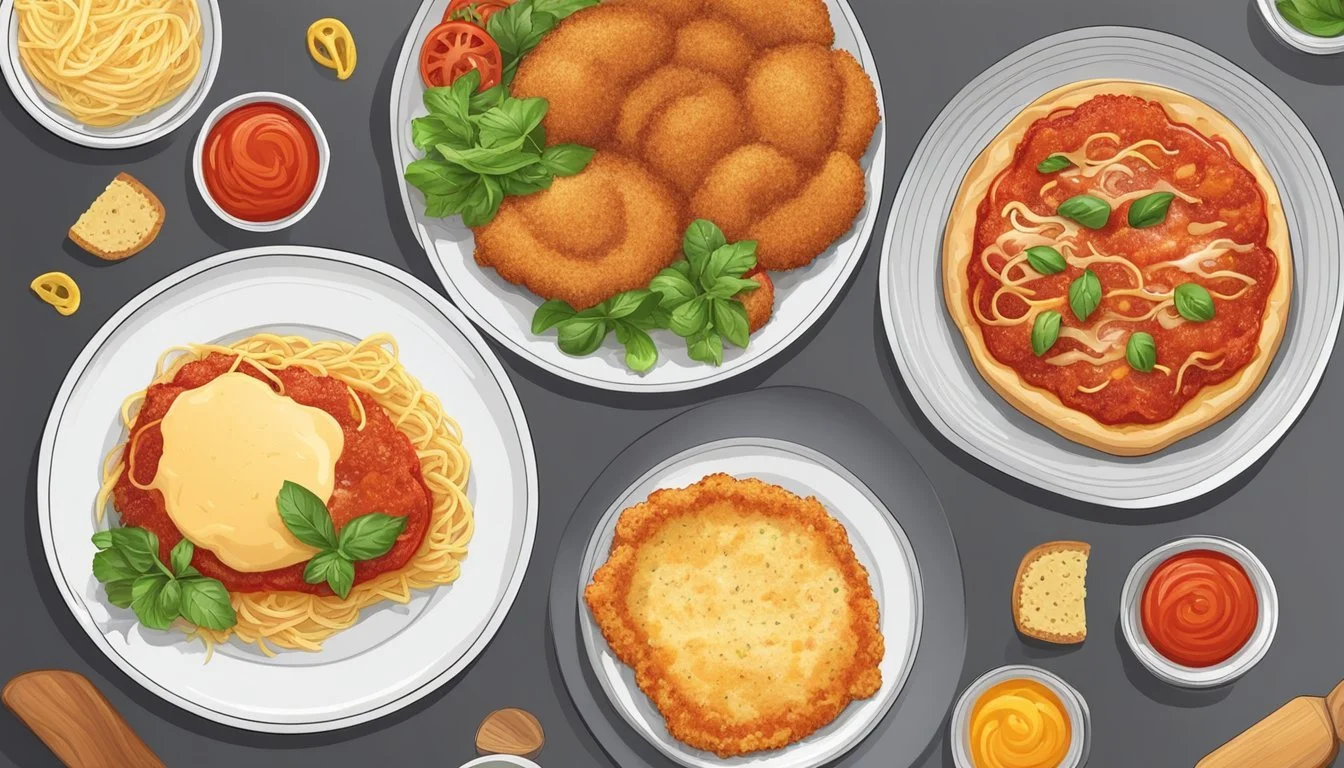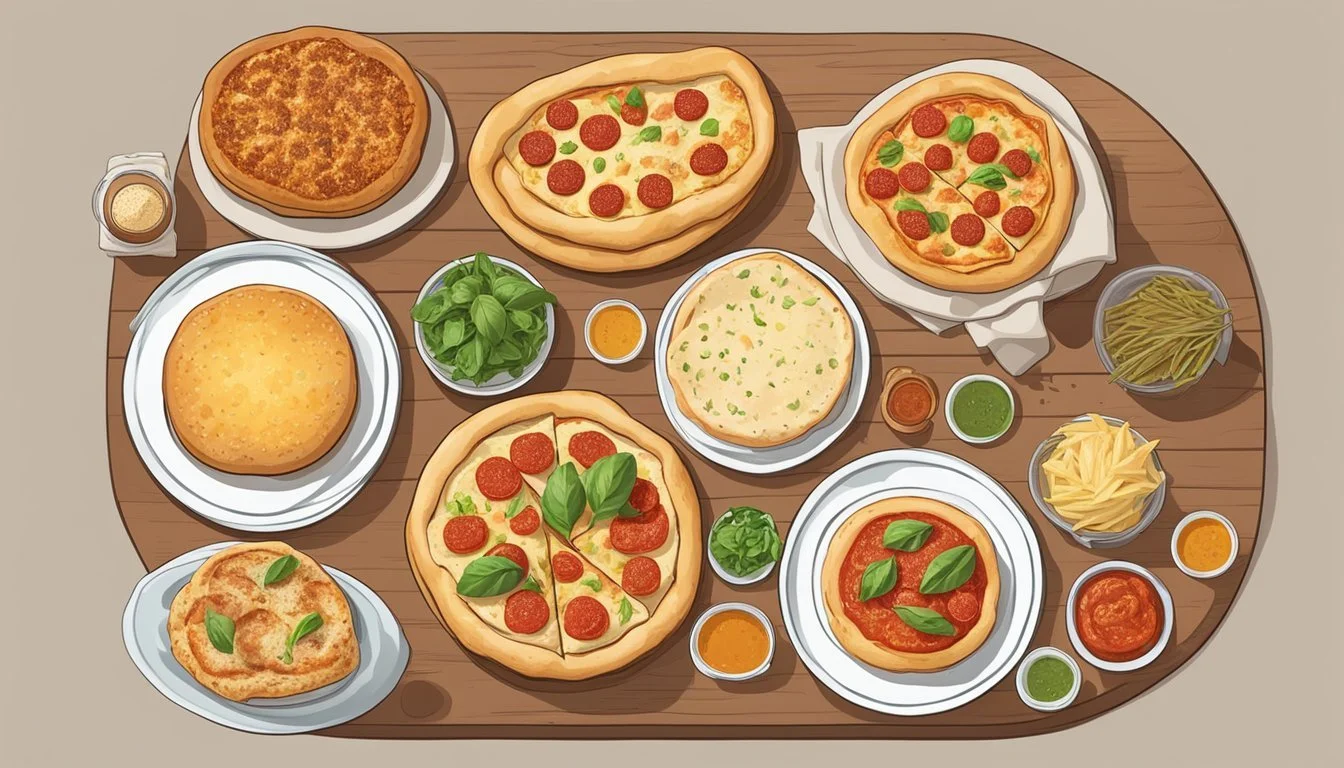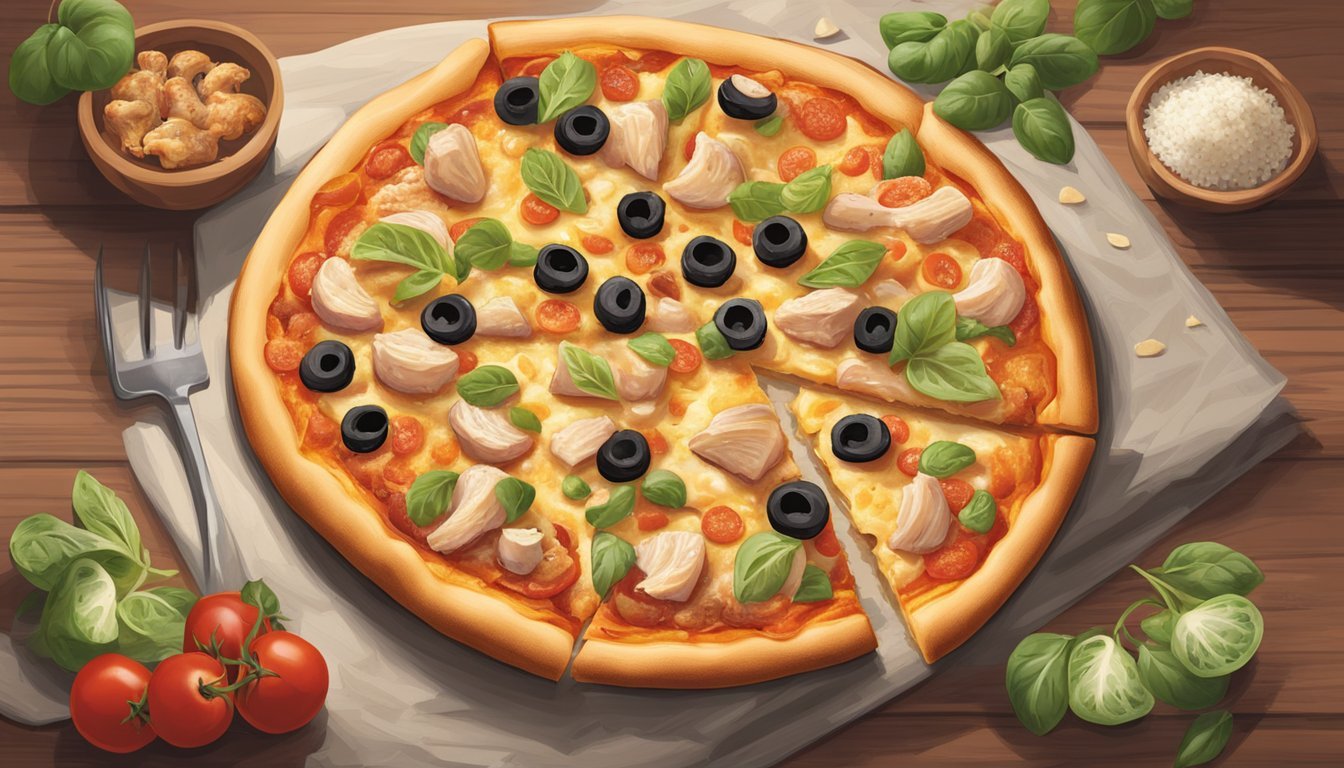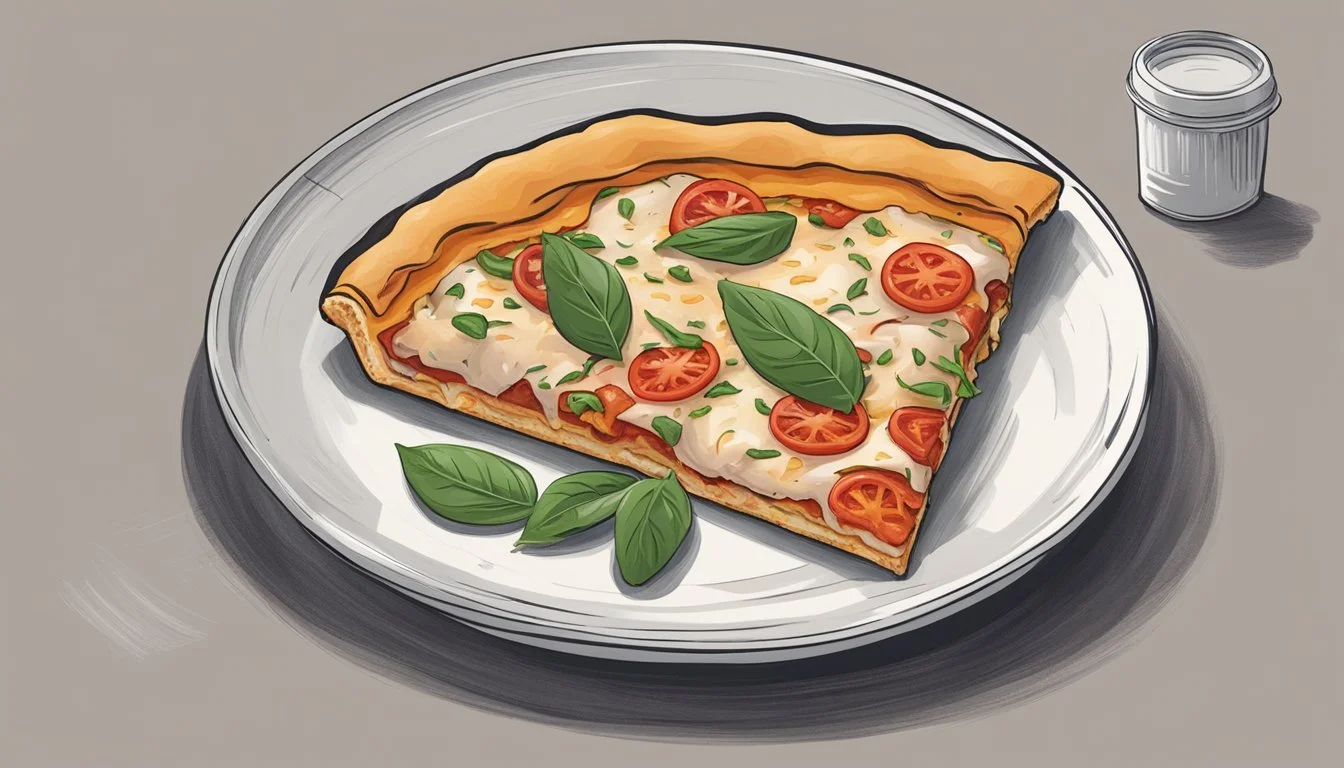Is Chicken Parmesan Pizza Vegan?
Unveiling the Truth About This Popular Dish
The dish chicken parmesan (What wine goes well with chicken parmesan?) traditionally combines breaded and fried chicken breasts with marinara sauce, mozzarella, and parmesan cheese, often served atop pasta or within a sandwich. However, this classic Italian-American entree is not vegan due to its use of chicken and dairy-based cheeses. In recent years, vegan interpretations of chicken parmesan have emerged, utilizing plant-based substitutes to mimic the flavors and textures of the original dish.
Vegan chicken parmesan typically features alternatives such as breaded tofu, mushrooms, or commercially available vegan "chicken" products. These are used as the base protein and are paired with vegan cheeses and marinara sauce free of animal products or byproducts. The evolution of vegan cheese has allowed for melty and flavorful toppings that closely resemble the qualities of dairy cheese without the use of animal milk.
The concept of vegan chicken parmesan pizza (What wine goes well with pizza?) takes the innovation a step further, combining the elements of vegan chicken parmesan with the ubiquitous comfort food, pizza. A vegan chicken parm pizza would consist of a crust topped with marinara sauce, plant-based chicken, and a mix of vegan mozzarella and parmesan cheese. When carefully prepared, vegan chicken parmesan pizza can offer a similar experience to the original, providing a cruelty-free alternative to those adhering to a vegan lifestyle.
Understanding Veganism
When discussing whether chicken parmesan pizza can align with a vegan diet, it's crucial to first understand the core principles of veganism and the substitutes that can make traditional non-vegan dishes plant-based.
Defining a Vegan Diet
A vegan diet excludes all animal products, including meat, dairy, and eggs. Vegans adhere to a plant-based diet that incorporates a variety of fruits, vegetables, legumes, grains, nuts, and seeds. The motivation behind veganism is often rooted in health considerations, ethical concerns regarding animal welfare, and environmental factors.
Key components of a vegan diet include:
Proteins: from sources like beans, lentils, tofu, and tempeh (What wine goes well with tempeh?).
Fats: obtained from avocados, nuts, and seeds.
Carbohydrates: sourced from vegetables, whole grains, and fruits.
Vitamins and Minerals: particularly vitamin B12 and iron, which are often supplemented.
Vegan Substitutes for Chicken Parmesan
To make a chicken parmesan pizza suitable for vegans, one must replace the chicken and cheese with plant-based alternatives.
For the "chicken" component:
Tofu: A versatile soy-based product that can be breaded and seasoned to mimic the texture and flavor of chicken.
Tempeh: Made from fermented soybeans and offering a firmer texture, tempeh can be sliced and used as a chicken substitute.
For the "parmesan" aspect:
Nutritional Yeast: A savory, cheese-flavored seasoning that can add a cheesy taste without any dairy.
Vegan Cheeses: These are often made from nuts, soy, or root vegetables and can be melted and browned similar to traditional cheese.
Components of Chicken Parmesan
Chicken Parmesan typically merges crispy chicken cutlets with tangy marinara sauce and melted cheese, a combination that's hard to replicate in a vegan context. However, with the right ingredients and substitutions, a vegan version can emulate the textures and flavors of the classic dish.
Chicken Parmesan Ingredients
Traditional Chicken Parmesan includes:
Protein base: Boneless chicken breasts or cutlets
Breading: All-purpose flour, breadcrumbs (often seasoned), and eggs
Seasonings: Garlic powder, onion powder, salt, and black pepper
Cheese: Parmesan and mozzarella cheese
Sauce: Marinara sauce, typically made from tomatoes (What wine goes well with tomatoes?), garlic, onions, and herbs
Vegan Chicken Alternatives
In vegan Chicken Parmesan, plant-based substitutes take the place of chicken and cheese:
Vegan protein base: Options include tofu, seitan (What wine goes well with seitan?) (vital wheat gluten), commercial vegan chicken cutlets, chopped mushrooms, or cauliflower.
Vegan breading: A mix of all-purpose flour, breadcrumbs, and non-dairy milk (e.g., almond milk) can replace traditional breading ingredients.
Vegan cheese: Dairy-free mozzarella and parmesan alternatives made from nuts or soy can be used for topping.
Preparing a vegan Chicken Parmesan involves selecting a suitable protein base that mimics the texture of chicken when cooked. Tofu and seitan are popular for their ability to absorb flavors and offer a meaty bite. Coating these proteins in seasoned breading and baking or frying them until crispy replicates the classic Chicken Parmesan cutlets. A robust marinara sauce and a final layer of melty vegan cheese complete the transformation, resulting in a comforting and familiar dish without the use of animal products.
Vegan Cheese Explained
When considering vegan alternatives for cheese in dishes like chicken parmesan pizza, vegan mozzarella, and parmesan are critical substitutes for their dairy counterparts. They provide the necessary textures and flavors without any animal products.
Vegan Mozzarella Options
Vegan mozzarella options have evolved significantly, providing both taste and meltability similar to traditional mozzarella. Key players in this category include:
Vegan Mozzarella Shreds: They are designed to melt and stretch, ideal for pizzas. Brands often use a blend of oils, tapioca starch, and pea protein to create this effect.
Dairy-free Mozzarella Blocks: These can be sliced for sandwiches or salads and contain coconut oil and soy protein as their base.
Vegan Mozzarella Cheese Spread: For creamy applications, these spreads come in handy and typically include cashew nuts and almond milk.
Vegan Parmesan Varieties
Vegan parmesan cheese, often used as a garnish, brings in a salty, umami flavor that enhances vegan pizzas, pastas, and more. Its varieties include:
Grated Vegan Parmesan: Commonly available as a shakeable topping made from nutritional yeast, nuts (like almonds or cashews), and seasonings.
Vegan Parmesan Blocks: These can be grated or shredded at home and might use a base of tofu for firmness.
Nutritional Yeast-based Parmesan: This is a simple, homemade option blending nutritional yeast flakes with garlic powder, onion powder, and salt.
These dairy-free cheese alternatives enable those following a vegan diet to enjoy a variety of textures and flavors reminiscent of traditional cheese while adhering to their dietary choices.
The Foundation: Breads and Crusts
When constructing a vegan chicken parmesan pizza, the bread or crust selected is critical, as it sets the stage for the toppings. It is important that the crust not only adheres to vegan standards but also provides the desired texture and flavor.
Choosing the Right Bread
For a vegan-friendly chicken parmesan pizza, one must select bread that contains no animal products. Bread forms the base of the pizza and must be scrutinized for dairy, eggs, and honey which are commonly found in many store-bought breads. Engine 2 Pizza Crust is one such verified vegan crust that is recommended for health-conscious consumers.
Ingredients: One should look for crusts made with whole wheat or gluten-free flours, yeast, water, and a pinch of salt.
Bread Type: Avoid enriched white breads and opt for whole grain or sourdough options for additional nutrients and flavor.
Vegan Brands: Seek out brands that specialize in vegan products to ensure compliance with vegan standards.
Ideal Bases for Vegan Pizzas
Creating a base that complements the vegan chicken parmesan topping is all about getting the baking process right. Choosing between a homemade pizza crust or a pre-made one can affect the outcome significantly.
Homemade Pizza Crust: Offers full control over ingredients but requires more preparation time.
Pre-made Vegan Crusts: Provides convenience and consistency, making for a quick and reliable option.
Here is a simple table to guide the choice of base:
Criteria Homemade Crust Pre-made Crust Ingredient Control Full Limited Preparation Time Longer Shorter Vegan Certification Home Verified Brand Certified Texture & Flavor Customization High Moderate
When baking, use a parchment-lined baking sheet to avoid sticking and achieve a uniformly crispy crust. Always pre-heat the oven to ensure the crust cooks evenly and acquires the right level of crispiness without burning. Whether one opts for homemade or store-bought crusts, care must be taken to avoid cross-contamination with non-vegan ingredients, particularly when using a shared baking sheet or toaster.
Crafting the Sauce
In the creation of vegan chicken parmesan pizza, the sauce is a central component that brings depth and richness to the dish. Two primary sauce variations can be employed - a classic tomato marinara sauce and a version enhanced with herbs.
Tomato and Marinara Sauce
The foundation of a good pizza sauce begins with quality tomatoes. One should use either a processed tomato sauce or pureed canned tomatoes as the base for marinara sauce. To this, finely minced garlic and onions are added for their aromatic qualities, contributing a subtle sweetness and robust flavor.
Key Ingredients for Tomato Marinara Sauce:
Tomatoes: Canned puree or sauce
Garlic: Freshly minced or garlic powder
Onions: Finely chopped
Simple Steps:
Sauté garlic and onions in a saucepan until aromatic.
Add the tomato base and simmer.
Flavor Enhancement with Herbs
Herbs elevate the marinara sauce from simple to sublime, infusing it with Italian flair. Basil, either as fresh minced basil or dried, is indispensable for its freshness and peppery undertones.
Herbs to Incorporate:
Italian Seasoning: A blend of dried herbs like oregano, rosemary, and thyme
Basil: Fresh for a bright flavor or dried for convenience
Process:
Incorporate Italian seasoning at the outset of simmering to meld flavors.
Stir in fresh basil towards the end of cooking to preserve its vibrant taste.
In both subsections, the cook maintains a gentle simmering process so flavors can slowly infuse under low heat, creating a sauce that complements the vegan chicken parmesan pizza.
Seasonings and Spices
The success of a vegan chicken parmesan pizza hinges on the mastery of seasonings and spices. Achieving a flavor profile reminiscent of traditional chicken parmesan without animal products requires a keen understanding of layering flavors for both marination and garnishing.
Creating a Flavorful Marinade
One must begin by crafting a marinade that imparts depth and richness to the vegan chicken substitute. Key ingredients include:
Soy sauce or vegetable broth: For a savory base.
Garlic: Minced or powdered to infuse a pungent taste.
Black pepper: Freshly ground to enhance the marinade with a sharp bite.
Italian seasoning: A blend of basil, oregano, rosemary, and thyme contributes classic Italian flair.
Poultry seasoning: Although the name suggests otherwise, it's typically a vegan-friendly mixture of sage, marjoram, rosemary, and nutmeg, which replicates the savory notes found in traditional poultry dishes.
These ingredients should be whisked together and used to marinate the vegan chicken alternative overnight, allowing the flavors to fully penetrate the substitute.
Herbs and Spices for Garnishing
After baking, a final flourish of herbs and spices can elevate the pizza's appeal:
Salt: A pinch can be sprinkled on top to balance the flavors.
Ground black pepper: A light dusting adds a final kick.
Fresh parsley: Chopped and scattered over the finished pizza as a fresh, herbaceous counterpoint to the rich vegan cheese and marinara sauce.
This final application of seasonings will not only add visual appeal but also enhance the overall flavor profile of the dish.
Baking Techniques
When crafting a vegan chicken parmesan pizza, understanding oven baking basics and exploring alternative baking methods is crucial to achieve the desired crispy crust and melted cheese-like topping.
Oven Baking Basics
For the best results, preheating the oven is essential; it should typically be set between 375°F to 425°F. Utilizing a baking sheet lined with parchment paper prevents sticking and ensures even cooking. If one prefers a crispier crust, a preheated pizza stone can substitute the baking sheet. To store leftover pizza, use an airtight container to maintain freshness.
Preheat the oven to the desired temperature before baking begins.
Line a baking sheet with parchment paper or use a pizza stone for a crispier base.
Bake until the vegan cheese toppings reach a bubbly and golden brown state, which could range between 15 to 25 minutes, depending on the oven and the toppings' thickness.
Alternative Baking Methods
In situations where an oven is not available or when one desires a different texture, alternative methods like broiling can be used. Broiling helps achieve a melty and slightly charred top layer in a shorter period. However, it requires close attention to prevent burning.
Use the broil setting for a few minutes towards the end of baking for a richer color and taste.
For those without an oven, countertop convection ovens are a viable alternative that still allows for the pizza to bake evenly.
Nutritional Considerations
When considering the nutritional aspects of chicken parmesan pizza made vegan, one should specifically examine the caloric and fat content, as well as how such a meal would fit into a balanced vegan diet.
Caloric and Fat Content
Chicken parmesan pizza, even in its vegan version, can be a significant source of calories and fats, depending on the choice of ingredients. Tofu, a common vegan substitute for chicken, generally has fewer calories and less fat than its meat counterpart. But the addition of vegan cheeses and sauces can increase both caloric and fat intake. For example, a slice of vegan chicken parmesan pizza could contain roughly:
Calories: 250-400
Total Fat: 10-20g
Saturated Fat: 2-4g
Carbohydrates: 30-50g
Certain variations, such as those that include vegan mozzarella and parmesan, add essential flavors but also fats – though typically less saturated fat than dairy-based cheeses.
Balancing a Vegan Diet with Pizza
In a vegan diet, where nutrition largely comes from plants, one must be mindful to include a variety of foods. Vegan chicken parmesan pizza can contribute to a balanced diet when portion control is practiced, and it's supplemented with nutrient-dense vegetables and whole grains. It's critical to consider the following in a vegan dinner recipe:
Fiber: Often found in the crust, if whole grain options are available.
Protein: Plant-based proteins like tofu are essential for muscle repair and satiety.
Vitamins and Minerals: Tomato sauce provides vitamin C and other antioxidants, while toppings like spinach or broccoli can boost vitamin and mineral intake.
A slice of vegan chicken parmesan pizza can be part of a healthy meal when combined with a salad or steamed vegetables to increase the nutrition profile of the dinner.
Serving and Storage
When enjoying vegan chicken parmesan pizza, the experience is greatly enhanced by the way it is served and stored. Proper serving ensures that this comfort food is enjoyed at its best, while correct storage prolongs its freshness.
Best Practices for Serving Vegan Pizza
One should serve vegan chicken parmesan pizza hot and fresh out of the oven for optimal taste and texture. To accompany the pizza, consider side dishes such as vegan baked ziti or a vegan caesar salad for a complete dinner experience. Serve the pizza on preheated plates to maintain its temperature during the meal.
Storing Leftovers Properly
Should there be any leftovers, they should be stored promptly to retain quality.
In the Fridge: Place leftover slices in an airtight container and refrigerate. Vegan pizza will keep for 2 to 3 days.
To Freeze: One may freeze individual pizza slices by wrapping them tightly in plastic wrap and placing them in an airtight container before storing in the freezer.
Reheat refrigerated or thawed frozen slices in a preheated oven until heated thoroughly to restore the pizza's original texture and warmth.
Related Vegan Recipes
When considering vegan adaptations of chicken parmesan pizza, it's essential to explore other Italian-inspired vegan dishes that can complement this main course.
Creating a Complete Vegan Dinner
For those aiming to assemble a complete vegan dinner, serving a vegan Caesar salad before the main course is an ideal choice. A classic Caesar salad can be made vegan by substituting the traditional anchovy dressing with a blend of cashews, nutritional yeast, lemon juice, and capers (What wine goes well with capers?) to mimic the savory, tangy flavor profile.
Vegan Caesar Salad Recipe:
Dressing: Blend soaked cashews, nutritional yeast, lemon juice, garlic, Dijon mustard, capers, and plant milk until smooth.
Salad: Toss chopped romaine lettuce and croutons with the dressing.
Continuing Italian culinary traditions, a vegan baked ziti serves as a hearty companion to the pizza. A vegan baked ziti is rich, indulgent, and can be prepared with a tomato-based marinara sauce, al dente ziti pasta, and a creamy cashew-based ricotta—all baked to perfection.
Vegan Baked Ziti Recipe:
Sauce: Simmer crushed tomatoes with garlic, basil, and oregano.
"Ricotta": Blend cashews, tofu, lemon juice, and nutritional yeast to a ricotta-like consistency.
Assembly: Layer cooked ziti with sauce and "ricotta" in a baking dish, and bake until bubbly.
Exploring More Italian Vegan Dishes
Expanding beyond the pizza, the realm of Italian vegan dishes encompasses a multitude of options, each offering the comfort and robust flavors of Italian-American cuisine. Dishes like vegan lasagna layering "cheese" made from almonds or soy, and eggplant parmesan (What wine goes well with eggplant parmesan?) using a chickpea flour-based batter for breading, captures the essence of the cuisine without compromising on taste or texture.
An exploratory cook might also concoct a vegan version of spaghetti and meatballs, using lentils or textured vegetable protein as a base for the meatballs, pairing it with a homemade marinara sauce seasoned with Italian herbs to maintain authentic flavors.
Making Vegan Chicken Parmesan Pizza
Creating a vegan chicken parmesan pizza involves carefully selecting plant-based ingredients to mimic the classic flavors and textures of the traditional dish. The process can be broken down into preparation and cooking, ensuring a crispy, golden result that is both delicious and animal-product free.
Step-by-Step Preparation
One starts by pressing the firm tofu to remove excess moisture, which is crucial for achieving the desired crispy texture. The tofu should be pressed for at least 30 minutes; an overnight press in an airtight container in the refrigerator can yield even better results. After pressing, the tofu is sliced and marinated in a mixture that often contains olive oil, vegan bouillon cubes or paste to infuse it with a chicken-like flavor, and nutritional yeast for cheesiness. For the breading, a combination of flour with seasonings, and sometimes tapioca starch, is used to coat the marinated tofu.
Cooking and Assembly
The baking sheet should be lined with parchment paper or tin foil and preheated in the oven to get a jump-start on crisping up the tofu. For a vegan chicken parm pizza, one can bake the breaded tofu at 350-425°F until it is crispy and golden. Once baked, the tofu is placed on a base of vegan pizza crust, topped with marinara sauce, and a generous sprinkling of vegan mozzarella and parmesan. It is then baked until the cheese becomes bubbly. Using a skillet can also be an alternative method where the breaded tofu is fried until golden before being placed on the pizza to bake.
Additional Resources
In this section, readers will find recommendations on specific products to create a vegan version of chicken parmesan pizza, along with insights into affiliate programs and ethical considerations to bear in mind when purchasing through affiliate links.
Recommended Products
For those looking to replicate the classic flavors of chicken parmesan pizza, here are some vegan alternatives:
Gardein: They offer plant-based chicken substitutes which can serve as the base protein for your pizza topping.
Violife: A popular choice for vegan cheese that melts well, Violife has a variety of styles, including one that mimics parmesan.
Daiya: This brand provides a range of dairy-free cheeses, and their mozzarella shreds are ideal for achieving the gooey consistency desired on pizzas.
Seitan: A wheat-based meat alternative that can be seasoned to replicate the taste and texture of chicken.
Products can typically be found at health food stores or online.
Affiliate Programs and Ethical Considerations
When purchasing through affiliate links, it's important to consider the programs behind them:
Amazon Associates: A common affiliate program where bloggers and websites earn commissions by linking to Amazon product pages.
Affiliate Links: Using these does not cost the consumer extra, but it helps support the content creators sharing valuable vegan product insights.
Consumers should always be aware that when you click on an affiliate link, the referrer typically makes a small commission from the seller at no additional cost to you. Checking the ethics and sustainability practices of the brands you support, such as Gardein, Violife, or Daiya, aligns your purchases with your values.
Personalization and Variations
In crafting a vegan version of chicken parmesan pizza, chefs can cater to various dietary restrictions and experiment with diverse flavors and toppings for a customized culinary experience.
Substitutions for Dietary Restrictions
For diners with dietary restrictions, key substitutions in the recipe can make chicken parmesan pizza fully vegan and satisfying. Seitan, a wheat-based meat substitute, can stand in for chicken with its meaty texture and high protein content. Those who are gluten-free might opt for cauliflower bites, which emulate the crunch and flavor when properly seasoned and baked. Almond milk, an excellent dairy-free alternative, can be used in place of cow’s milk alongside all-purpose flour or a gluten-free alternative to create a roux for vegan cheeses and sauces. Incorporating fresh herbs like fresh parsley also adds depth and brightness to the dish, complementing the tanginess of tomato sauce and the savory flavors of vegan cheese.
Creative Toppings and Flavors
To add a twist to the traditional, one might explore a variety of creative toppings and flavors:
Sauces: A rich marinara or even a pesto spread can serve as a flavorful base.
Vegan Cheeses: Nutritional yeast or vegan parmesan alternatives crafted from cashews offer a cheesy umami flavor without dairy.
Garnishes: A sprinkle of fresh parsley not only adds color but also a fresh, herbaceous note.
A vegan chicken parmesan pizza thrives on innovation. Cooks can play with different ingredients, discovering the combinations that best suit their palate while honoring the original dish's spirit.
FAQs in Vegan Chicken Parmesan
When it comes to creating a vegan chicken parmesan, the recipe may raise several questions about ingredients and methods. This section addresses common inquiries and provides practical advice to ensure an appetizing outcome.
Common Questions
What substitutes are used for chicken in vegan chicken parmesan?
Typically, tofu and seitan are popular meat substitutes. Tofu offers a neutral flavor that absorbs seasonings well, while seitan provides a chewier texture akin to chicken.
Can you achieve the same cheesy flavor without dairy?
Yes. Vegan mozzarella and parmesan, often made from nuts or soy, melt and impart a creamy texture and rich flavor reminiscent of traditional cheese.
Tips and Tricks for the Perfect Dish
Achieving the Perfect Crust:
Tofu: Press tofu to remove excess water and achieve a firmer texture.
Seitan: For a crispier crust, coat the seitan cutlets in a mixture of breadcrumbs and nutritional yeast before baking.
Flavorful Marinade:
Create a marinade with vegetable broth, hot sauce, and seasonings such as dried poultry seasoning and smoked paprika. Marinate overnight to infuse the tofu or seitan with depth of flavor.












